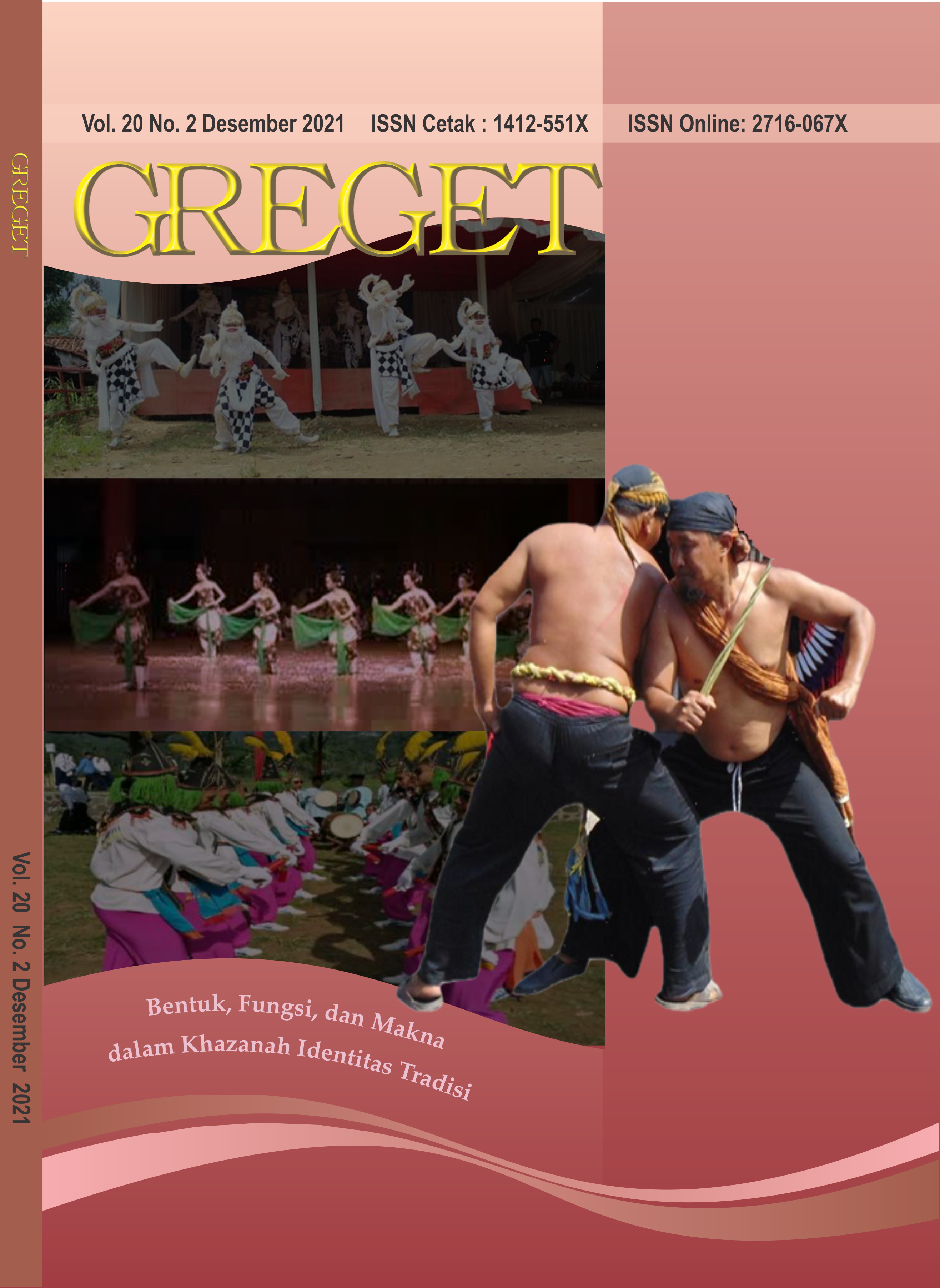MAKNA TARI GANDHONG DI DESA BANGUN KECAMATAN MUNJUNGAN KABUPATEN TRENGGALEK
Main Article Content
Abstract
Downloads
Article Details
Copyright
Authors who publish with GREGET agrees to the following terms:
- Authors retain copyright and grant the journal right of first publication with the work simultaneously licensed under a Creative Commons Attribution-ShareAlike 4.0 (CC BY-SA 4.0) that allows others to share the work with an acknowledgment of the work's authorship and initial publication in this journal.
- Authors are able to enter into separate, additional contractual arrangements for the non-exclusive distribution of the journal's published version of the work (e.g., post it to an institutional repository or publish it in a book), with an acknowledgment of its initial publication in this journal.
- Authors are permitted and encouraged to post their work online (e.g., in institutional repositories or on their website) prior to and during the submission process, as it can lead to productive exchanges, as well as earlier and greater citation of published work.
References
Eris, Lusia. 2019. “Fungsi Kesenian Gandhong Di Desa Bangun Kecamatan Munjungan Kabupaten Trenggalek”. Skripsi S-1 Jurusan Seni Karawitan Fakultas Seni Pertunjukan Institut Seni Indonesia, Surakarta.
Femilia Kristian Arum Sari dan Setyo Yanuartuti tahun. 2020. Jurnal “Kajian Struktur Pertunjukan Tari Gandhong di Desa Bangun Kecamatan Munjungan Kabupaten Trenggalek”.
Fitriani, Ria. 2016. ”Pragmatik Tari Kiongkong Sabuk Janur Dusun Plawan Ngargoyoso Karanganyar”. Skripsi S-1 Jurusan Seni Tari Fakultas Seni Pertunjukan Institut Seni Indonedia, Surakarta.
Haryono, Sutarno. 2010 Kajian Pragmatik Seni Pertunjukan Opera Jawa. Surakarta: ISI Press Solo.
Lisa, Marinda. 2018. “Jaranan Pogogan Teguh Rahayu Desa Sugih Waras Kecamatan Prambaon Kabupaten Nganjuk (Kritik Seni Holistik)”. Skripsi S-1 Jurusan Seni Tari Fakultas Seni Pertunjukan Institut Seni Indonesia, Surakarta.
Maryono. 2010. Pragmatik Genre Tari Pasihan Gaya Surakarta. Surakarta: ISI Press Solo.
. 2010. “Komponen Verbal Nonverbal dalam Genre Tari Pasihan Gaya Surakarta (Kajian Pragmatik)”. Disertasi S-3 Program Pascasarjana Program Studi Lingustik Universitas Sebelas Maret.
. 2011. Penulisan Kualitatif Seni Pertunjukan. Surakarta: ISI Press Solo
. 2015. Analisa Tari. Surakarta: ISI Press Solo
MD, Slamet. 2003. Barongan Blora. STSI Press Surakarta.
. 2016. Melihat Tari. Surakarta. Karanganyar: Citra Sains
Sari, Yunita. 2016. “Tari Bugis Kembar versi S. Ngaliman Kajian Kritik Holistik. Skripsi S-1 Jurusan Seni Tari Fakultas Seni Pertunjukan Institut Seni Indonesia, Surakarta.
Soedarsono. 1978. Pengantar Pengetahuan Tari. Yogyakarta: Akademi Seni Tari Indonesia.
Soemaryatmi dan Suharji. 2015. Sosiologi Seni Pertunjukan Pedesaan. Surakarta: ISI Press.
Subroto, PH, 1985. Sistem Pertanian Tradisional Pada Masyarakat Jawa Tinjauan Secara Arkeologis dan Etnografis. Yogyakarta: Departemen Pendidikan dan Kebudayaan Direktorat Jendral Kebudayaan.
Suharji, 2017. Sosiologi Seni Pengantar Secara Sistematik. Surakarta: ISI Press
Tasman, Agus. 2008. Analisa Gerak dan Karakter. Surakata. ISI Press.
